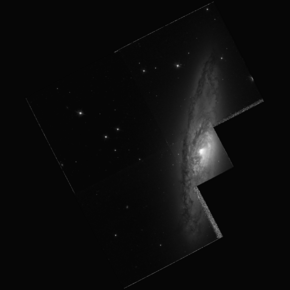NGC 6810
| NGC6810 | |
|---|---|
 NGC 6810 | |
| Observation data (J2000.0epoch) | |
| Constellation | Pavo |
| Right ascension | 19h43m34.25s[1] |
| Declination | −58° 39′ 20.12″[1] |
| Redshift | 0.006775[1] |
| Heliocentric radial velocity | 2031 ± 10km/s[1] |
| Distance | 87 Mly[1] |
| Apparent magnitude(V) | 11.60[2] |
| Apparent magnitude(B) | 12.40[2] |
| Characteristics | |
| Type | SA(s)ab:sp[1] |
| Apparent size(V) | 3.2 x 0.9[1] |
| Other designations | |
| PGC63571,ESO142-35 | |
NGC 6810is aspiral galaxyapproximately87 millionlight-yearsaway from Earth in theconstellationofPavo.[1]
Observational history
[edit]NGC 6810 was discovered byJohn Herschelon July 10, 1834.[3]It was later added to theNew General CataloguebyJohn Louis Emil Dreyer.
Misclassification of NGC 6810
[edit]This galaxy used to be classified as aSeyfert 2 galaxy,but that is probably incorrect.[4]Recent X-ray observations provide no evidence of anyactive galactic nucleus (AGN)activity,[4]and high resolution optical spectra do not confirm the status of NGC 6810 as a Seyfert galaxy, thus it appears to have been misclassified.[4][5]
Features
[edit]NGC 6810 is an early-type spiral of roughly equivalent mass to theMilky Way.[4]X-ray, optical, IR and radio properties of NGC 6810 are all consistent with astarburst galaxy.[4]
Galactic-scale superwind
[edit]Observation of NGC 6810 withXMM-Newtonreveals the presence of extended soft X-ray emission within theoptical discof the galaxy (which is closely associated withstar-forming regions) and also beyond the optical disc.[4]This, along with Hα filamentation and peculiar minor axis ionized gas kinematics, strongly suggest that NGC 6810 is host to agalactic-scale superwind[4]which is streaming from the starburst region.[6]
The actively star-forming regions and the base radius of the outflow are unusually spread out, and extend out to a radius of ~6.5 kpc from the nucleus. Most superwinds in other galaxies appear to arise in ≲ 1 kpc-scale nuclear starburst regions.[4]That makes NGC 6810 one of the few ‘disc-wide’ superwinds currently known,[4]because NGC 6810's superwind base extends across nearly 70 percent of the entire galaxy's diameter.[6]Only three other starburst galaxies are known to have broad superwind sources.[6]
See also
[edit]References
[edit]- ^abcdefgh"NASA/IPAC Extragalactic Database".ned.ipac.caltech.edu.Retrieved28 November2017.
- ^ab"Revised NGC Data for NGC 6810".spider.seds.org.RetrievedDecember 9,2017.
- ^"Data for NGC 6810".www.astronomy-mall.com.RetrievedDecember 9,2017.
- ^abcdefghiStrickland, David K. (2007)."A new superwind galaxy: XMM–Newton observations of NGC 6810".Monthly Notices of the Royal Astronomical Society.376(2): 523–533.arXiv:astro-ph/0701630.Bibcode:2007MNRAS.376..523S.doi:10.1111/j.1365-2966.2007.11478.x.S2CID13834527.
- ^Forbes, Duncan A.; Norris, R. P. (1998)."Star Formation in Southern Seyfert Galaxies".Monthly Notices of the Royal Astronomical Society.300(3): 757.arXiv:astro-ph/9804298.Bibcode:1998MNRAS.300..757F.doi:10.1046/j.1365-8711.1998.01940.x(inactive 2024-07-17).S2CID3719096.Retrieved3 December2017.
{{cite journal}}:CS1 maint: DOI inactive as of July 2024 (link) - ^abc"Blowin' in the galactic superwind".www.astronomy.com.Retrieved3 December2017.
External links
[edit]- NGC 6810 onWikiSky:DSS2,SDSS,GALEX,IRAS,Hydrogen α,X-Ray,Astrophoto,Sky Map,Articles and images
- SEDS
